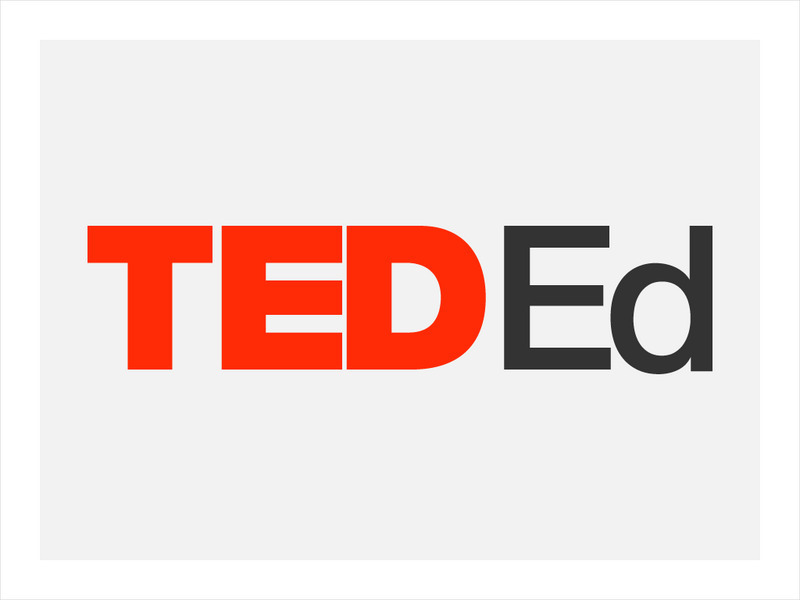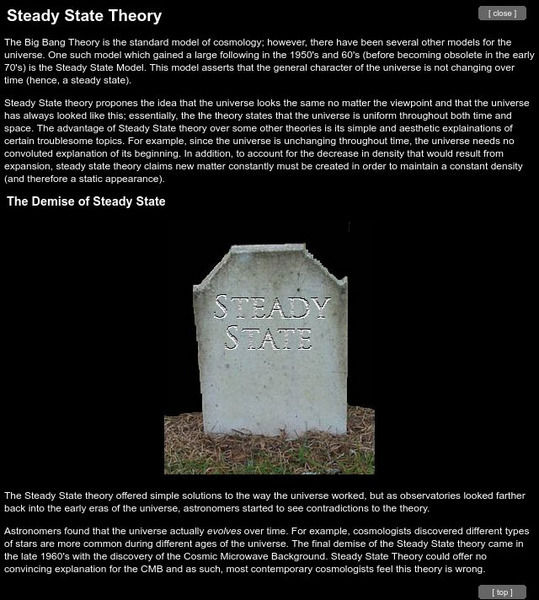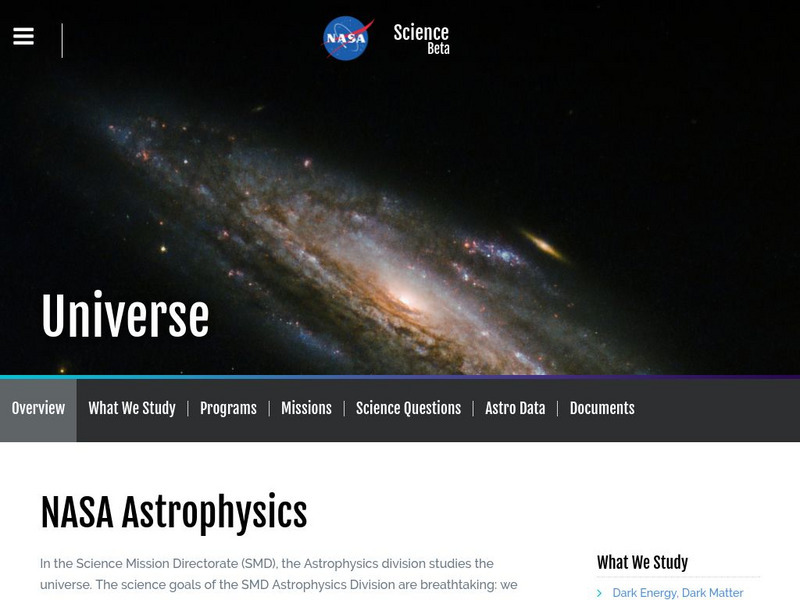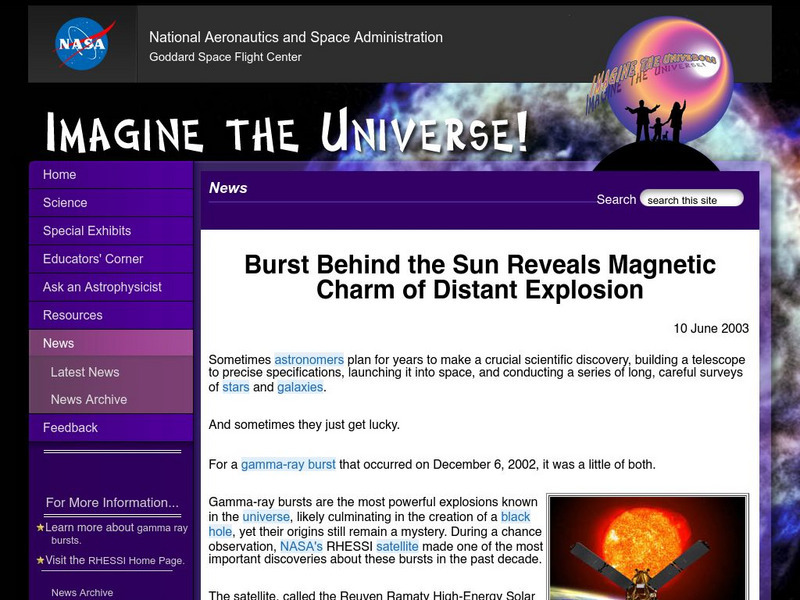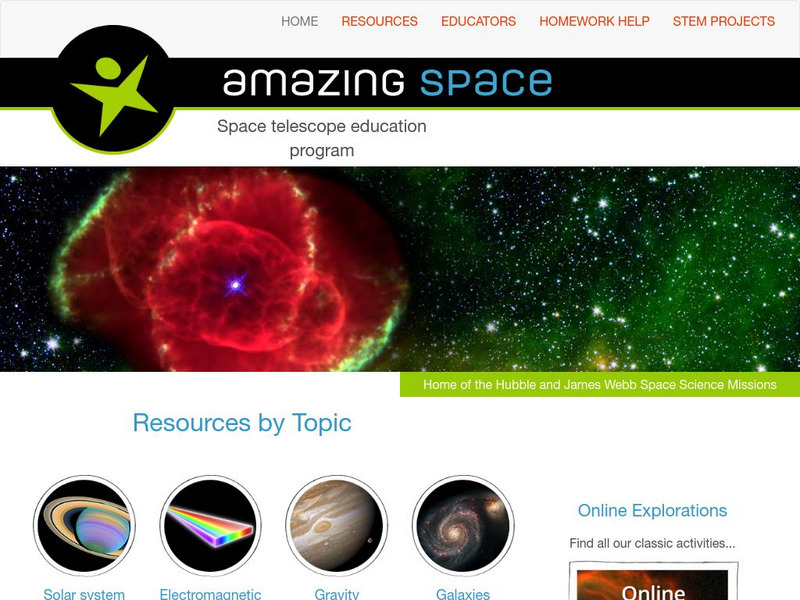National Institute of Educational Technologies and Teacher Training (Spain)
Ministerio De Educacion: La Tierra, Un Planeta en Continuo Cambio
In this unit you can learn about the history of our planet Earth. It has 25 interactive activities.
Smithsonian Institution
Smithsonian Learning Lab: The Universe, an Introduction
Start with the questions all students ask: How big is the universe, how far away are the planets and stars, how did they form and when, how do they move and why? Build on their natural curiosity. The Smithsonian, in cooperation with...
National Institute of Educational Technologies and Teacher Training (Spain)
Ministerio De Educacion: El Universo, La via Lactea Y El Sistema Solar
Ministerio de Educacion: El Universo, la Via Lactea y el Sistema Solar.
Wikimedia
Wikipedia: The Black Hole
This site examines the black hole as an object in astrophysics. Delve into this comprehensive resource that covers this concept from its history, to qualitative physics, the reality of black holes, mathematical physics and more.
TED Talks
Ted: Ted Ed: How Do We Study the Stars?
Yuan-Sen Ting takes us into deep space to show how astronomers study the stars beyond our reach. [4:46]
TED Talks
Ted: Ted Ed: A 3 D Atlas of the Universe
Carter Emmart has been coordinating the efforts of scientists, artists, and programmers to build a complete 3D visualization of our known universe. He demos this stunning tour and explains how it's being shared with facilities around the...
TED Talks
Ted: Ted Ed: The Sound the Universe Makes
We think of space as a silent place. But physicist Janna Levin takes us on an accessible and mind-expanding soundwalk through the universe. [17:44]
TED Talks
Ted: Ted Ed: Is There a Center of the Universe?
It's been a long road to the discovery that Earth is not the center of the Solar System, the Milky Way, or the universe; great thinkers from Aristotle to Bruno have grappled with it for millennia. But if we aren't at the center of the...
TED Talks
Ted: Ted Ed: How Small Are We in the Scale of the Universe?
In 1995, scientists pointed the Hubble Telescope at an area of the sky near the Big Dipper. The location was apparently empty, and the whole endeavor was risky- what, if anything, was going to show up? But what came back was nothing...
TED Talks
Ted: Ted Ed: Could Human Civilization Spread Across the Whole Galaxy?
Could human civilization eventually spread across the whole Milky Way galaxy? Could we move beyond our small, blue planet to establish colonies in the multitude of star systems out there? These questions are pretty daunting, but their...
TED Talks
Ted: Ted Ed: Carl Sagan on the Existence of Extraterrestrials
Carl Sagan discusses the incomprehensible vastness of the universe, the wonder of our own place in it all, and the science behind understanding the likelihood of the existence of extraterrestrial beings. [6:24]
Other
University of Cambridge: Astro Adventure
Imagine a time when you can travel through space, planet to planet, cheaply and in comfort, when you can take a trip to the stars as your next holiday. Well, imagine no more. Learn more about the solar system as you take this trip of a...
Other
Universe Adventure: Steady State Theory
We have all heard of the Big Bang Theory for the beginning of the universe, but there are other theories of how it all began. Here is a brief explanation of the Steady State Theory, a theory which is no longer thought to be a possibility.
Other
Senlin: A Biography
Conrad Aiken's poem is reproduced in its entirety here, in distinct parts. Easy to read, but no commentary accompanies the poem.
Space Telescope Science Institute
Amazing Space: Hubble Deep Field Academy
At this site, students can become a Steller Statistician, Cosmic Classifier, Galactic Guide or a Universal Graduate by attending the Hubble Deep Field Academy--and entering information in their Hubble Academy Log (HAL), which is assessed...
PBS
Pbs Teachers: Mysteries of the Universe
Consider the issues surrounding the world of space exploration including the new fields of archaeoastronomy and astrobiology. Investigate zero gravity, the Big Bang theory, life in space and how sound travels in a vacuum.
Scholastic
Scholastic: Study Jams! Science: Our Solar System: The Universe
A video and a short multiple-choice quiz on the Universe and what it is made up of.
Smithsonian Institution
National Air and Space Museum: Explore the Universe
This resource explores the history of the universe and its explorers.
Australian Museum
Australian Museum: The Earth: The Universe
Basic information about the universe, its origin and composition. Also includes information about galaxies, stars, and the sun.
NASA
Nasa: Space Place: What Is the Big Bang?
With exciting illustrations, NASA's Space Place explains the theory of the origin of the universe known as the Big Bang.
Space Telescope Science Institute
Nasa: Hubble Space Telescope: Universe
At this site from HubbleSite you can discover the universe by taking a look back toward the beginning of time. Site contains links to information on planets, stars, galaxies, and much more.
NASA
Nasa: Astrophysics
This colorful study looks at how our universe was formed and how others can be formed. It also contains beautiful images of various formations in our own universe.
NASA
Nasa: Imagine the Universe: "Burst Behind the Sun"
Site provides the article, "Burst Behind the Sun Reveals Magnetic Charm of Distant Explosion," that details on a gamma-ray burst that occurred on December 6, 2002. Provides graphics and links to learn more about gamma-ray bursts.
Space Telescope Science Institute
Space Telescope Science Institute: Amazing Space
Amazing Space promotes the "science and majestic beauty of the universe for use in the classroom." Here you can find learning activities, lesson plans, teaching guides, and helpful tips for students eager to learn about space and space...










